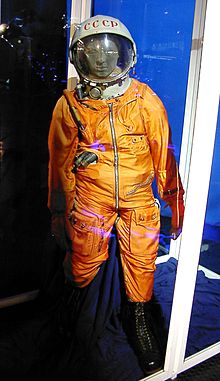SK-1 (space suit)
SK-1 (abbreviation for "Skafandr Kosmitscheskij 1", Russian Скафандр Космический for "cosmic skaphander" = space suit) is a Soviet space suit that was developed and manufactured by the Soviet company NPP Zvezda for space flights with Vostok space ships .
conditions
- Ensuring hygienic conditions for space travelers for up to twelve days
- Protection of the cosmonaut in the event of a pressure drop in the cabin in orbit for five hours and return to the landing capsule within 25 minutes
- Protection of the cosmonaut when exiting with the ejection seat up to heights of eight kilometers with a dynamic pressure of 2800 kg / m²
- Provision of oxygen during parachute landing
- Ensuring the survival of the wearer in cold water for twelve hours and for three days at temperatures of −15 ° C
construction
The SK-1 spacesuit has an open life support system that uses the cabin air during normal operation. Emergency oxygen is used in an emergency. The suit consists of two separate airtight layers, once an outer layer of polyethylene terephthalate and an inner layer of rubber, which are below a heat-resistant outer layer. The helmet is firmly attached to the suit and equipped with a double visor that can close automatically. The gloves are removable. To regulate the temperature, SK-1 has an internal heat protection suit with ventilation and cooling. The shoes are optimized for landing the cosmonaut on a parachute . If the wearer lands in the water, the collar of the suit inflates automatically with the help of a CO 2 cartridge. The SK-1 suit has a headset and an emergency radio for communication . The total weight of the suit is 20 kg.
The SK-1 was developed from the W-3 pressure suit, from which it took over the thermal protective suit and ventilation, and the S-10 suit, the helmet of which was further developed and equipped with an automatic locking mechanism. The outer protective cover was derived from the Vorkuta pilot suit.
SK-2
A variant called SK-2 was developed for female cosmonauts , which is technically completely identical, but adapted to the female body.
commitment
Twenty SK-1 models and four SK-2 models were produced for property testing and development. In order to test the suit in space, two dummies with the unofficial name "Iwan Iwanowitsch" were developed, whose weight characteristics were human-like and which had various sensors for recording measurements. The test manikins were built with the help of the Moscow Institute for Prosthetic Technology and had fully articulated arms and legs. There was even a mustache painted on the head. To test the radio communication, radio was received in the cabin and sent back to earth via the headset. This should avoid misinterpretation and confusion with real people.
On April 12, 1961, Yuri Gagarin was the first person to fly into space on board Vostok 1 . He was wearing an SK-1 suit. A total of eleven airworthy SK-1 and SK-2 models were built, two of which were tested with dummies in space, five SK-1 suits were used in other Vostok missions. In one of the two SK-2 suits, Valentina Tereschkowa flew into space with Vostok 6 on June 16, 1963.
Further development
For the subsequent Vozhod and Soyuz flights, space suits were not worn in the command module for reasons of capacity. For this reason, three cosmonauts were killed during the flight of Soyuz 11 in 1971. After that, NPP Zvezda developed the Sokol suit for the Soyuz spaceship, which is still in use.
At the same time, space suits for stepping out into free space ( EVA ) were developed.
swell
- Isaak P. Abramow, A. Ingemar Skoog: Russian Space Suits. Springer Practice, 2003, ISBN 1-85233-732-X .
- Wokrug Sweta: A Brief History of the Origin and Development of Soviet and Russian Space Suits (Russian; archived March 2016)

